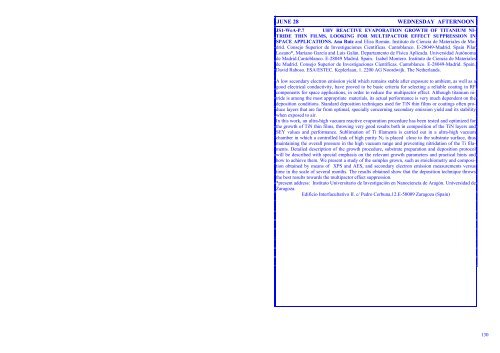Wüest M. 51 Wykes M. 82 Yamaguchi M. 17 Ybarra G. 129 Yubero F ...
Wüest M. 51 Wykes M. 82 Yamaguchi M. 17 Ybarra G. 129 Yubero F ...
Wüest M. 51 Wykes M. 82 Yamaguchi M. 17 Ybarra G. 129 Yubero F ...
You also want an ePaper? Increase the reach of your titles
YUMPU automatically turns print PDFs into web optimized ePapers that Google loves.
JUNE 28 WEDNESDAY AFTERNOON<br />
JS1-WeA-P.7 UHV REACTIVE EVAPORATION GROWTH OF TITANIUM NI-<br />
TRIDE THIN FILMS, LOOKING FOR MULTIPACTOR EFFECT SUPPRESSION IN<br />
SPACE APPLICATIONS. Ana Ruiz and Elisa Román. Instituto de Ciencia de Materiales de Madrid.<br />
Consejo Superior de Investigaciones Científicas. Cantoblanco. E-28049-Madrid. Spain Pilar<br />
Lozano*, Mariano García and Luis Galán. Departamento de Física Aplicada. Universidad Autónoma<br />
de Madrid.Cantoblanco. E-28049 Madrid. Spain. Isabel Montero. Instituto de Ciencia de Materiales<br />
de Madrid. Consejo Superior de Investigaciones Científicas. Cantoblanco. E-28049-Madrid. Spain.<br />
David Raboso. ESA/ESTEC. Keplerlaan, 1. 2200 AG Noordwijk. The Netherlands.<br />
A low secondary electron emission yield which remains stable after exposure to ambient, as well as a<br />
good electrical conductivity, have proved to be basic criteria for selecting a reliable coating in RF<br />
components for space applications, in order to reduce the multipactor effect. Although titanium nitride<br />
is among the most appropriate materials, its actual performance is very much dependent on the<br />
deposition conditions. Standard deposition techniques used for TiN thin films or coatings often produce<br />
layers that are far from optimal, specially concerning secondary emission yield and its stability<br />
when exposed to air.<br />
In this work, an ultra-high vacuum reactive evaporation procedure has been tested and optimized for<br />
the growth of TiN thin films, throwing very good results both in composition of the TiN layers and<br />
SEY values and performance. Sublimation of Ti filaments is carried out in a ultra-high vacuum<br />
chamber in which a controlled leak of high purity N 2 is placed close to the substrate surface, thus<br />
maintaining the overall pressure in the high vacuum range and preventing nitridation of the Ti filaments.<br />
Detailed description of the growth procedure, substrate preparation and deposition protocol<br />
will be described with special emphasis on the relevant growth parameters and practical hints and<br />
how to achieve them. We present a study of the samples grown, such as stoichiometry and composition<br />
obtained by means of XPS and AES, and secondary electron emission measurements versus<br />
time in the scale of several months. The results obtained show that the deposition technique throws<br />
the best results towards the multipactor effect suppression.<br />
*present address: Instituto Universitario de Investigación en Nanociencia de Aragón. Universidad de<br />
Zaragoza.<br />
Edificio Interfacultativo II. c/ Pedro Cerbuna,12.E-50009 Zaragoza (Spain)<br />
130
















